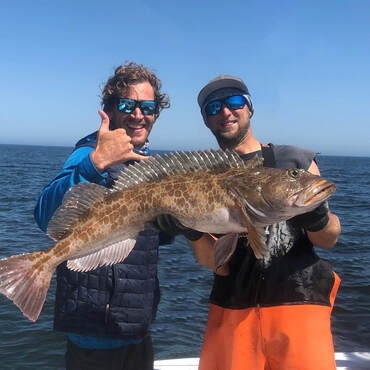
Bottom Fishing 101
Techniques and tactics for Bottom Fishing vary greatly depending on where you fish and the type of fish that are targeted. This document is intended for Shake N Bake clients and outlines how we do it on the Shake N Bake.
Bottom fish are not only fun to catch, but they are also excellent eating. One of the great parts of bottom fishing is that you never know exactly what you will bring up from the deep. It could be a brightly colored Canary rock fish, a prehistoric looking Ling Cod or even a Halibut.
Bottom fish are generally found near rocky formations. We fish in waters that are between 90-130 feet deep. Your captain will position the boat over the rocky bottom and allow the boat to drift over the rocks. It may not seem like it, but the boat will be moving slowly over the bottom. As the fish see your bait, they will leave the safety of the rocks to go aggressively eat your bait.
Getting your bait down to the fish
Your deckhand will get you set up with your rod and bait. Hold your weight and bait and drop both over the side. Ensure before letting the bait down that your bait and weight are not tangled. With your thumb on the spool to prevent a backlash, slide the lever drag back to “free spool” and slowly let the line out as your use your thumb on the spool to meter out the line. Do not remove your thumb from the spool as this will cause a backlash in your reel. You do not have to let your line out slowly, but you do not want to let it out too fast as that will cause your bait to tangle with you weight. You should let out your line slowly enough to feel your weight as it bends your rod tip. Once your weight hits the bottom, you will feel it thump on the bottom. We use braided line which has no stretch so feeling the bottom is made easier. Once your weight thumps the bottom, quickly put the lever drag into the strike position and reel the line in 2-3 full rotations reel handle. Bigger swells and stronger winds can make feeling the bottom more difficult. If you have trouble feeling the bottom, talk to your deckhand. He may recommend using a heavier weight in such situations.
You want your weight to be near the bottom, but you do not want it to be dragging the bottom. You can occasionally lift your rod and lower it until the weight thumps on the bottom again to re-test that you are close to the bottom. The rock formations where we fish are not of a consistent depth so you will find that sometimes you no longer feel the bottom in which case you will need to re-test the bottom by slowly letting more line out. Other times, you will start dragging bottom as you drift over a shallower rock formation. You may feel the weight drag on the bottom or you just may feel your line go slack. Do not wait too long once you feel you are dragging bottom or your line goes slack. Put your reel in gear quickly and crank the reel handle until you no longer feel your weight dragging or have taken the slack out of the line. Then re-test the bottom until your weight thumps on the bottom again before cranking it up a couple of turns on the reel.
Techniques and tactics for Bottom Fishing vary greatly depending on where you fish and the type of fish that are targeted. This document is intended for Shake N Bake clients and outlines how we do it on the Shake N Bake.
Bottom fish are not only fun to catch, but they are also excellent eating. One of the great parts of bottom fishing is that you never know exactly what you will bring up from the deep. It could be a brightly colored Canary rock fish, a prehistoric looking Ling Cod or even a Halibut.
Bottom fish are generally found near rocky formations. We fish in waters that are between 90-130 feet deep. Your captain will position the boat over the rocky bottom and allow the boat to drift over the rocks. It may not seem like it, but the boat will be moving slowly over the bottom. As the fish see your bait, they will leave the safety of the rocks to go aggressively eat your bait.
Getting your bait down to the fish
Your deckhand will get you set up with your rod and bait. Hold your weight and bait and drop both over the side. Ensure before letting the bait down that your bait and weight are not tangled. With your thumb on the spool to prevent a backlash, slide the lever drag back to “free spool” and slowly let the line out as your use your thumb on the spool to meter out the line. Do not remove your thumb from the spool as this will cause a backlash in your reel. You do not have to let your line out slowly, but you do not want to let it out too fast as that will cause your bait to tangle with you weight. You should let out your line slowly enough to feel your weight as it bends your rod tip. Once your weight hits the bottom, you will feel it thump on the bottom. We use braided line which has no stretch so feeling the bottom is made easier. Once your weight thumps the bottom, quickly put the lever drag into the strike position and reel the line in 2-3 full rotations reel handle. Bigger swells and stronger winds can make feeling the bottom more difficult. If you have trouble feeling the bottom, talk to your deckhand. He may recommend using a heavier weight in such situations.
You want your weight to be near the bottom, but you do not want it to be dragging the bottom. You can occasionally lift your rod and lower it until the weight thumps on the bottom again to re-test that you are close to the bottom. The rock formations where we fish are not of a consistent depth so you will find that sometimes you no longer feel the bottom in which case you will need to re-test the bottom by slowly letting more line out. Other times, you will start dragging bottom as you drift over a shallower rock formation. You may feel the weight drag on the bottom or you just may feel your line go slack. Do not wait too long once you feel you are dragging bottom or your line goes slack. Put your reel in gear quickly and crank the reel handle until you no longer feel your weight dragging or have taken the slack out of the line. Then re-test the bottom until your weight thumps on the bottom again before cranking it up a couple of turns on the reel.
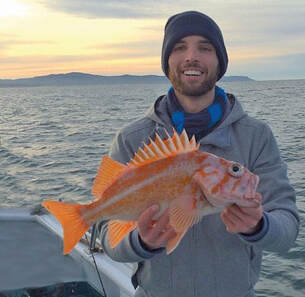
Dealing with snags
Unless you are near the bottom with your bait you will not catch fish, so occasionally snagging the bottom is inevitable if you are doing it right. When you do snag the bottom work quickly to free your weight from the rocks. Reel down to take out any slack and then shake the rod tip rapidly to try to free your weight from the rocks. If you are unable to free the snag, call your deckhand for help. They may have better luck freeing your weight, or they may just have to break it off and tie on another weight.
Fishing Technique
Once your weight and bait are just off the bottom, the real fun begins. Allow your bait to hover just off the bottom. Other than occasionally retesting to feel the bottom, there is no need to jig your bait up and down especially if there is any sort of swell. The Ocean will provide all the vertical action that you need. Bottom fish are generally aggressive, so the bite is generally not hard to feel. Do not set the hook as soon as the fish starts eating your bait. Allow the fish to bite on your bait for 3-4 seconds before setting the hook.
Unless you are near the bottom with your bait you will not catch fish, so occasionally snagging the bottom is inevitable if you are doing it right. When you do snag the bottom work quickly to free your weight from the rocks. Reel down to take out any slack and then shake the rod tip rapidly to try to free your weight from the rocks. If you are unable to free the snag, call your deckhand for help. They may have better luck freeing your weight, or they may just have to break it off and tie on another weight.
Fishing Technique
Once your weight and bait are just off the bottom, the real fun begins. Allow your bait to hover just off the bottom. Other than occasionally retesting to feel the bottom, there is no need to jig your bait up and down especially if there is any sort of swell. The Ocean will provide all the vertical action that you need. Bottom fish are generally aggressive, so the bite is generally not hard to feel. Do not set the hook as soon as the fish starts eating your bait. Allow the fish to bite on your bait for 3-4 seconds before setting the hook.
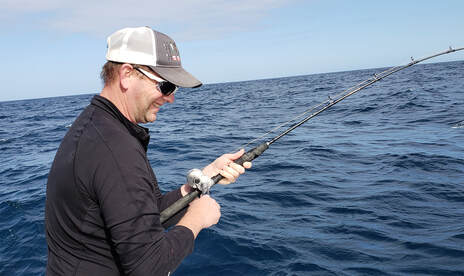
Setting the Hook
Make sure your lever drag is in the strike position, before setting the hook. Once you waited your 3-4 seconds, reel down so that your rod tip is near the surface of the water and then lift the rod tip skyward as you begin cranking. Bottom fish can try to make it back to the rocks to cut you off so keep cranking.
Fight the fish with your non dominant hand above the reel. Place the butt of the rod in your abdomen at the beltline.
As you bring your fish up to the surface you should take care not to tangle with the other anglers on the boat. Tangles can happen while bottom fishing, but if everyone pays attention you can minimize tangles.
Landing Your Fish
As you bring your catch to the surface you may notice the fish stop fighting. Some species of bottom fish have an air bladder which expands and as they come to the lower pressure water near the surface. Notify your deckhand that you have a fish ready to be landed as you see fish approach the surface. Depending on the species and size of the fish, your deckhand may choose just to lift the fish onboard or he may choose to net it. In the event your deckhand wants to net your fish, keep the fish in the water just below the surface. Do not let your line go slack, maintain a tight line between your rod and the fish.
Make sure your lever drag is in the strike position, before setting the hook. Once you waited your 3-4 seconds, reel down so that your rod tip is near the surface of the water and then lift the rod tip skyward as you begin cranking. Bottom fish can try to make it back to the rocks to cut you off so keep cranking.
Fight the fish with your non dominant hand above the reel. Place the butt of the rod in your abdomen at the beltline.
As you bring your fish up to the surface you should take care not to tangle with the other anglers on the boat. Tangles can happen while bottom fishing, but if everyone pays attention you can minimize tangles.
Landing Your Fish
As you bring your catch to the surface you may notice the fish stop fighting. Some species of bottom fish have an air bladder which expands and as they come to the lower pressure water near the surface. Notify your deckhand that you have a fish ready to be landed as you see fish approach the surface. Depending on the species and size of the fish, your deckhand may choose just to lift the fish onboard or he may choose to net it. In the event your deckhand wants to net your fish, keep the fish in the water just below the surface. Do not let your line go slack, maintain a tight line between your rod and the fish.
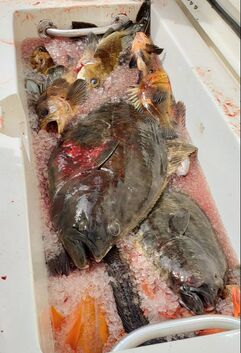
Once your deckhand lifts the fish into the boat, pull some line out of your reel to provide him a little slack. Do this by grabbing the line near the reel and pulling it away from the reel. 2-3 feet of slack is generally sufficient. Hold your rod with the tip straight up in the air and grab the weight so that it does not swing around. We use 8–12-ounce cannon ball sinkers and they hurt if you or someone else gets hit with one. Follow your deckhand across the deck until he has removed the hook from the fish. Hooks and sinkers are notorious for getting caught up in the net especially when there is an energetic Ling Cod flipping around in the net. Once your hook is free from the fish, reel in the slack and while maintaining control of the hook and weight. Once your deckhand has taken care of the fish, he will check your leader for frays and get you baited up once again.
Missed Fish
You may occasionally have a fish bite but not get hooked. Give your bait another 30 seconds to a minute and then reel in. We always carry plenty of bait and there is no sense fishing a mangled bait or a bare hook.
Safety note:
When fishing is good, we may have several fish sliding around on the deck. Bottom fish often have spines and sharp quills. Their gills can also have razor sharp edges. Avoid stepping on them and do not kick them to move them around on the deck. A spine will easily go through a shoe or rubber boot. Take care when picking one up as a fish that looks dead can quickly come to life and flip violently.
Missed Fish
You may occasionally have a fish bite but not get hooked. Give your bait another 30 seconds to a minute and then reel in. We always carry plenty of bait and there is no sense fishing a mangled bait or a bare hook.
Safety note:
When fishing is good, we may have several fish sliding around on the deck. Bottom fish often have spines and sharp quills. Their gills can also have razor sharp edges. Avoid stepping on them and do not kick them to move them around on the deck. A spine will easily go through a shoe or rubber boot. Take care when picking one up as a fish that looks dead can quickly come to life and flip violently.
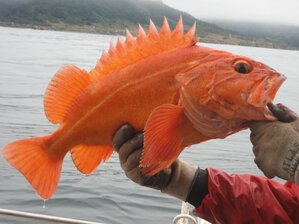
Prohibited Species
Certain Species of fish are not allowed to be kept and others can be kept but in limited numbers. Still others have size minimums. For example: Ling Cod must by 22 inches or longer to be kept. One of the prohibited species is the Yellow Eye Rockfish. Your deckhand will identify the species that must be released and will use a descender device to safely return those with inflated air bladders back to the bottom where their air bladders will deflate and they can swim away unharmed.
Certain Species of fish are not allowed to be kept and others can be kept but in limited numbers. Still others have size minimums. For example: Ling Cod must by 22 inches or longer to be kept. One of the prohibited species is the Yellow Eye Rockfish. Your deckhand will identify the species that must be released and will use a descender device to safely return those with inflated air bladders back to the bottom where their air bladders will deflate and they can swim away unharmed.